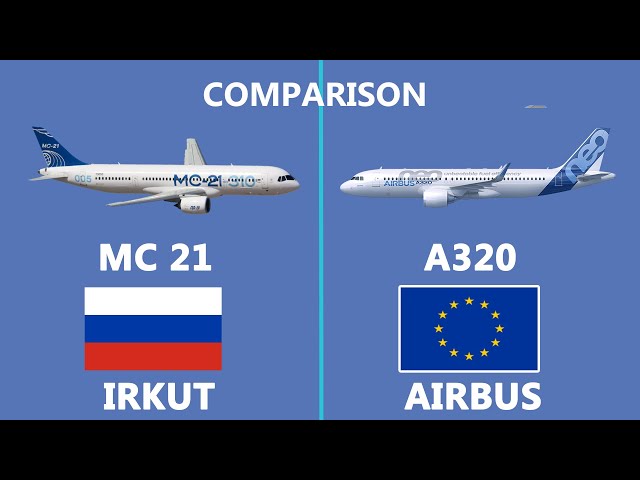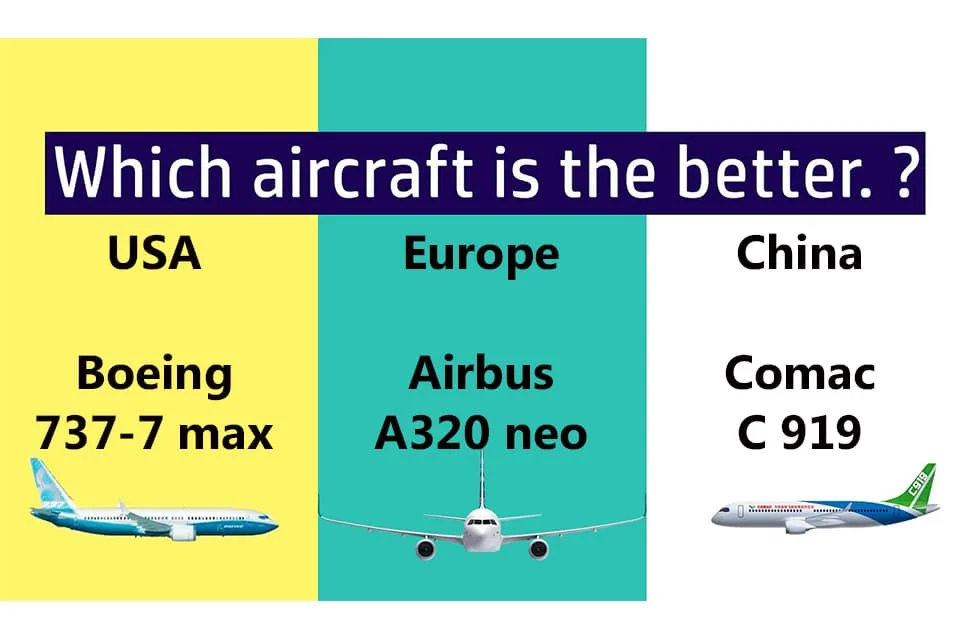Aircraft comparison
Comparison of Russian Irkut MC-21vs Airbus A320neo

Russia is on the brink of advancing its aircraft industry in response to Western countries’ sanctions on aerospace components. They are developing a potential competitor to Western aircraft such as the Boeing 737 Max and the Airbus A320.
The Irkut MC-21 and the Airbus A320 are both narrow-body, single-aisle commercial aircraft designed for short to medium-haul flights. While the Airbus A320 has been a longstanding and widely used aircraft in the aviation industry, the Irkut MC-21 is a newer entrant that aims to compete in the same market segment.
In this article, we will conduct a comprehensive comparison between two notable aircraft: the MC 21 and the A320. Join us as we delve into each section to gain a better understanding of these aircraft and their capabilities.
mc 21
The MC-21, also called the Irkut MC-21, is a cutting-edge, contemporary narrow-body twinjet airliner built in Russia that was created and manufactured by Irkut Corporation. The MC-21, which made its first flight in 2017, is a technological be amazed at its advanced aerodynamics, fuel efficiency, and roomy, passenger-friendly cabin.
The well-known narrow-body, twin-engine Airbus A320 is now a mainstay of the world’s aviation fleet. Since its introduction in 1988, the A320 family has come to represent efficiency, dependability, and state-of-the-art technology. Airlines can choose the A320 series as a flexible option for short- to medium-haul routes with its unique wide cabin and sophisticated fly-by-wire control system.
In terms of cockpit crew, both aircraft accommodate a standard two-person crew. However, when it comes to passenger capacity, the MC-21-300 offers a configuration with 163 seats in a two-class setup (16J + 147Y), while the A320 has a slightly smaller capacity with a range of 140 to 240 passengers.
Moving on to dimensions, the MC-21-300 has a length of 42.2 meters (138 ft), whereas the A320 is slightly shorter at 37.57 meters (123 ft 3 in).
The MC-21-300 also has a wider wingspan, standing at an unspecified width, compared to the A320’s 35.8-meter (117 ft 5 in) wingspan.
The MC-21-300 has a maximum take-off weight of 79,250 kg (174,720 lb), slightly exceeding the A320’s maximum take-off weight of 78,000 kg (172,000 lb).
With a maximum payload of 22,600 kilograms (49,800 pounds), the MC-21-300 surpasses the A320, which has a maximum payload of 19.9 tons (44,000 pounds). This can impact the aircraft’s flexibility in carrying passengers, cargo, or a combination of both.
The MC-21-300 boasts a 2-class range of 6,000 kilometers (3,200 nautical miles), while the A320 has a range of 3,300 nautical miles (6,100 kilometers) under certain parameters. The MC-21-300 is equipped with Aviadvigatel PD-14 turbofan engines, while the A320 features the Pratt & Whitney PW1431G engines with a thrust of 31,000 lbf (140 kN).
Engine Upgrade
The Airbus A320 stands out as a popular aircraft in the narrowbody segment, offering a range that spans from shorter distances to longer routes. Airbus has extended its capabilities with the introduction of the much-anticipated A321XLR, designed for extended flights. The aircraft showcases breakthrough technologies that contribute to its overall advancement.
Notably, Airbus has experienced a higher number of orders for its narrowbody aircraft compared to its competitors. The A320neo, or “New Engine Option,” represents a significant leap forward. It boasts new engine choices, allowing airlines to opt for either the Pratt & Whitney PW1000G geared turbofan engine or the CFM International LEAP-1A engine.
In response to past challenges with one of its engines, Airbus is gradually transitioning to CFM engines. The previous engine-related issues resulted in setbacks for airlines and manufacturers alike. This shift underscores Airbus’s commitment to addressing concerns and ensuring the reliability of its aircraft.
The A320neo, an enhanced iteration of the A320, is a testament to Airbus’s dedication to incorporating cutting-edge technologies and more fuel-efficient engines. This evolution aims to improve overall performance while aligning with environmental sustainability goals.
As per reports from Russian sources, the Irkut MC-21 has achieved a milestone by successfully concluding over 160 test flights powered by the PD-14 engine. Furthermore, the aircraft’s wing has undergone a comprehensive test cycle, demonstrating positive endurance results. The PD-14 engine, developed by the United Engine Corporation (UEC), has played a pivotal role in the aircraft’s success, complementing the domestically produced composite wing.
Orders
Recently, Sergey Skuratov, the director-general of Ural Airlines, unveiled the carrier’s ambitious plan to acquire 40 Irkut MC-21s for its fleet. This announcement signals a noteworthy shift in Russia’s aviation landscape, as many airlines in the country are considering the adoption of domestically manufactured aircraft to replace their existing narrow-body planes sourced from Western countries. This move represents a significant milestone for Russia as it endeavors to establish a more prominent presence in the global commercial aviation sector.
While Airbus, with its extensive worldwide customer base and a substantial number of airplane orders, may not feel an immediate impact, the potential loss of the Russian market could pose challenges. The MC-21’s success in the Chinese market, in particular, could present hurdles for Airbus, given its significant market share. Despite facing sanctions on Western components, Russia continues to operate its A320 fleet, showcasing its resilience in meeting current and future demands for aviation passengers.

Aircraft comparison
Comparison between Comac C919 and A320 aircraft

The COMAC C919 and the Airbus A320 represent two significant players in the narrow-body commercial aircraft market, each reflecting its manufacturer’s vision for the future of aviation.
The C919, developed by the Chinese aerospace manufacturer COMAC, aims to challenge established Western dominance with its advanced technology and cost-effective design. In contrast, the Airbus A320, a stalwart of global aviation for decades, continues to set benchmarks for efficiency, safety, and passenger comfort.
This comparison explores the key differences and similarities between these two aircraft, highlighting their design philosophies, performance metrics, and market implications.
How the Comac C919 similar from the A320 and B737 Max:Click here
The COMAC C919, predominantly built using aluminum alloys, is equipped with CFM International LEAP turbofan engines. It has the capacity to accommodate between 156 and 168 passengers in its standard configuration.
This twin-engine jet features a six-abreast economy cabin layout. Initially, it offered options for either CFM56 or IAE V2500 turbofan engines, though the CFM56/PW6000 combination was exclusively used for the A318 model. It can accommodate 195 passengers.
COMAC C919 vs. Airbus A320: A Comparative Overview
Length: The C919 measures 38.9 meters (127.6 feet) in length, slightly longer than the A320, which is 37.57 meters (123 feet 3 inches) long. This extra length provides a marginally larger cabin for the C919.
Wingspan: Both aircraft share the same wingspan of 35.8 meters (117.5 feet), indicating similar aerodynamic properties and potential for comparable fuel efficiency and performance.
Height: The C919 stands at 11.95 meters (39.2 feet) in height, surpassing the A320’s height of 11.76 meters (38 feet 7 inches). This difference is relatively minor but may impact cabin space and cargo hold configuration.
Aircraft comparisons between the comac C919 and B737 max 8:Click here
Weight: The COMAC C919 has a maximum takeoff weight of 42,100 kilograms (92,815 pounds), slightly less than the A320’s 42.6 tonnes (93,900 pounds). The A320’s marginally higher weight suggests it may be able to handle slightly more payload or fuel.
Range: The C919 offers a range of 4,630 kilometers (2,500 nautical miles), which is shorter compared to the A320’s range of 6,112 kilometers (3,300 nautical miles). This extended range of the A320 makes it better suited for longer routes and provides airlines with more operational flexibility.
Nearly twice as much as the $50 million that analysts predicted, comac c919 price is roughly $91 million. That is comparable to the cost of the Boeing 737-800 and the Airbus A320neo, which, as of 2021, are estimated to be $106 million and $111 million, respectively.
-

 Travel1 week ago
Travel1 week agoAir India to Expand US Operations with Three New Routes After a Decade
-

 Travel2 weeks ago
Travel2 weeks agoWhy We Should Avoid These Stamps in a Passport
-

 Airlines1 month ago
Airlines1 month agoInvestigations Reveal Fake Chinese Titanium in Boeing and Airbus Jets
-

 Tech4 weeks ago
Tech4 weeks agoChina’s CATL Plans 1,800-Mile Electric Plane Launch by 2027
-

 Airport3 days ago
Airport3 days agoTop 10 Largest Airports in the World by Size
-

 Aerospace4 weeks ago
Aerospace4 weeks agoChina’s Fighter Jets Turn Wings into Autonomous Drones
-

 Airlines4 days ago
Airlines4 days agoAir India Rolls Out A350s for Delhi-New York JFK and Newark Routes
-

 Defence3 weeks ago
Defence3 weeks agoBoeing Enhances Chinook with New Engines and Block II Upgrades at $96 Million







